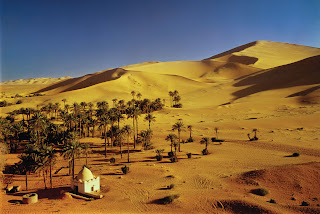Basic Facts of Algeria
Official name : Democratic and Popular Republic of Algeria,
Capital : Algiers Area 2,381,741 sq km 919,595 sq mi,
Population : 33,739,635 (2008 estimate),
Population density : 14 persons per sq km, 37 persons per sq mi (2008 estimate)
Urban/rural distribution:
Share urban 60 percent, Share rural 40 percent (2005 estimate),
Largest cities: Algiers, Oran,Constantine
Languages: Arabic (official), Tamazight, Berber dialects, Frenc,
Religious affiliations:
Muslim (Islam is the official religion) 96 percent,
Non religious 3 percent
Christian, Jewish, and other 1 percent,
Life expectancy:
Total 73.8 years
Female 75.5 years
Male 72.1 years (2008 estimate),
Literacy rate:
Total 72.2 percent,
Female 63.6 percent,
Male 80.6 percent (2005 estimate)
Introduction:
Algeria, country in northwestern Africa that borders the Mediterranean Sea, officially known as the Democratic and Popular Republic of Algeria. Algeria is the second largest country on the African continent. Only Sudan covers more area. The Sahara, a vast desert, spreads over nine-tenths of the country. Coastal plains lie near the Mediterranean, separated by mountains from the Sahara. The overwhelming majority of Algeria’s people live in the northern part of the country, near the coast. Algiers, along the Mediterranean coast, is the country’s capital and largest city. Algeria’s name in Arabic, al-Jaza’ir (“the islands”), refers to small islands lying off the coast near the capital.
The harbor in Algiers, the capital of Algeria, is one of northwest Africa’s principal Mediterranean ports and a refueling station for ships. Two sections of the city exist, the modern French lower side and the Casbah, an old area named after the 16th-century fortress located in its narrow, winding streets.
An Oasis in the Sahara
Huge chains of sand dunes called ergs appear in the Sahara, forming the Grand Erg Occidental (Great Western Erg) and the Grand Erg Oriental (Great Eastern Erg). The Kerzaz oasis, shown here, is in the Western Erg.Camel Caravan
Using pack animals to haul people and goods is still a typical mode of transportation in rural parts of the world. In the Hogar Mountains of Algeria, the Tuareg people use camel caravans as their primary means of transportation.United by Islam
At Illizi, Algeria, Arabs and Tuaregs answer the daily call to prayer with a reading of the Qur'an, the holy book of Islam. Written in Arabic, the Qur'an offers spiritual and moral guidance as well as practical tenets by which to live, with particular emphasis on community. Islam came to Algeria in the 7th century ad.



